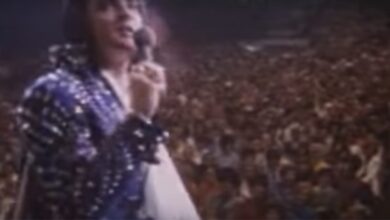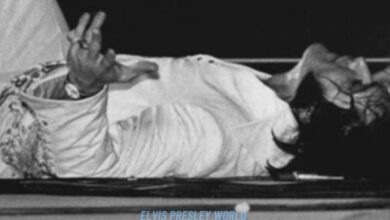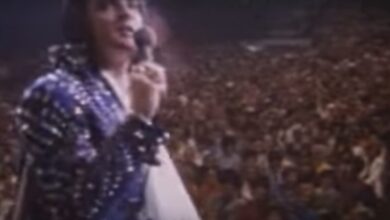No Auto-Tune, No Lasers, Only Pure Talent That Transformed the World
Elvis Presley remains a pivotal figure in the evolution of modern music and popular culture, with his performance of “Money Honey” on May 6, 1956, at the New Frontier Hotel in Las Vegas marking a significant chapter in his illustrious career. This two-week engagement at the New Frontier was not only his Las Vegas debut but also an exploration of his growing influence in the entertainment landscape. At the time, Elvis was at a crucial juncture in his career. He had just signed with RCA Records and was experiencing a meteoric rise in popularity, thanks in large part to the success of hits like “Heartbreak Hotel.”
“Money Honey,” originally performed by Clyde McPhatter and The Drifters, took on a new life in Elvis’s capable hands. His rendition infused the song with a unique energy and charisma that only he could deliver. It was during this performance that audiences began to see the fusion of rock and roll with the Southern charm that defined Elvis’s appeal. His ability to transform a relatively simple song into an electrifying experience encapsulated his artistry and foreshadowed his dominance in the music scene.
Elvis’s performances during this Las Vegas engagement were pivotal not only for his personal career but also for the music industry itself. Elvis stepped onto the stage at a time when Las Vegas was dominated by traditional crooners and lounge acts—a stark contrast to his energetic rock and roll style. Despite initial skepticism from some critics, his magnetism and vocal prowess quickly won over audiences, solidifying his reputation as a groundbreaking performer who could captivate diverse crowds.
The setlist that Elvis delivered during his Las Vegas shows was a powerful testament to his versatility as an artist. Alongside “Money Honey,” he showcased songs like “Blue Suede Shoes,” “Hound Dog,” and “Heartbreak Hotel,” each demonstrating his range and ability to convey emotion through music. The dynamic interactions he had with the audience underscored a critical element of his performances—an innate ability to build a connection that transcended the barriers between performer and crowd.
While the atmosphere of Las Vegas presented challenges, they ultimately contributed to shaping Elvis’s stage presence. His innovative approach to live performances began to set new standards in the entertainment world. In an era where precision and polish often took precedence, Elvis’s raw energy and spontaneity provided a refreshing alternative that resonated with the public, establishing a new paradigm for future entertainers.
Elvis’s Las Vegas engagement also played out against the backdrop of an explosive year for him in 1956. His appearances on television shows such as the Dorsey Brothers’ Stage Show and The Milton Berle Show further propelled his fame, allowing him to reach broader audiences who had yet to fully embrace rock and roll. These television performances made it evident that Elvis was not just a musician; he was a cultural phenomenon who would shape the future of American entertainment.
Recording sessions during this year further underscored his prolific output. With hits like “Lawdy Miss Clawdy” and “Shake, Rattle and Roll,” Elvis was not just a performer but also a defining voice in rock and roll. His debut album, “Elvis Presley,” released in March 1956, achieved a remarkable milestone by becoming the first rock and roll album to top the Billboard chart, earning him his inaugural gold record. This achievement signaled the dawn of a new era in music, one where rock and roll would become dominant.
The impact of Elvis’s artistic choices during this time period was profound. His ability to merge various musical genres, including gospel, blues, and country, laid the groundwork for future artists to explore their own creative paths. His performance style inspired countless musicians, reshaping how future generations approached live shows.
As Elvis continued to evolve, his Las Vegas performances set a precedent that would influence the nature of residencies in the years to come. The energy and spectacle he brought to his shows would inform how major artists approached live performances, leading to elaborate stage designs, choreographed routines, and a greater focus on audience engagement.
Reflecting on his performance of “Money Honey” at the New Frontier Hotel, it becomes evident that this event was not merely a footnote in Elvis’s career; it was a significant milestone that foreshadowed the direction of his future endeavors. This engagement marked the beginning of his extensive relationship with Las Vegas, where he would later solidify his status as the “King of Rock ‘n’ Roll,” performing to sold-out crowds and establishing a legacy that endures to this day.
Overall, Elvis Presley’s performance of “Money Honey” in Las Vegas on May 6, 1956, represents more than just a moment in time; it reflects the birth of a cultural icon. His dynamic stage presence and musical innovations not only changed the course of his career but also left an indelible mark on the music industry that continues to resonate with artists and audiences around the world. As we continue to celebrate his contributions, we acknowledge how he redefined the possibilities of what a musical performance could entail, paving the way for the rock and pop icons of today.



